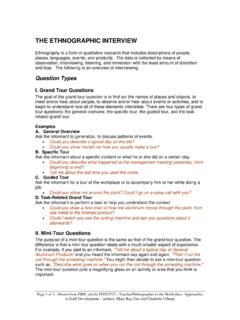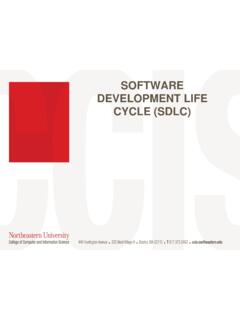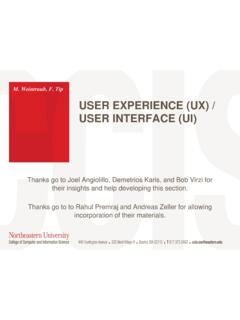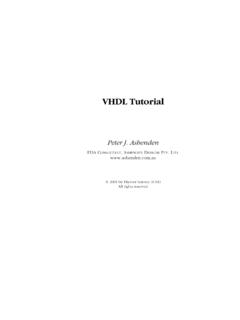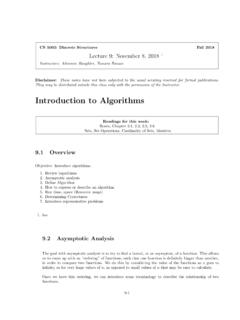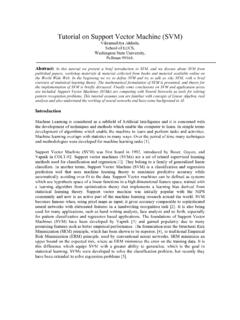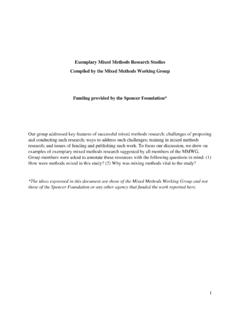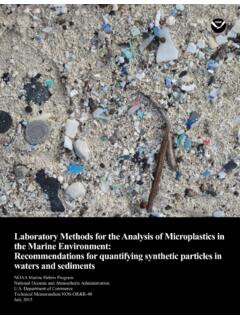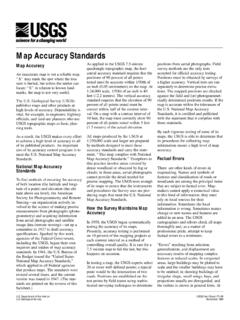Transcription of Module 1 Qualitative Research Methods Overview
1 Qualitative Research Methods : A Data Collector s Field GuideModule 1 Qualitative Research Methods OverviewFAMILY HEALTH INTERNATIONALOVERVIEWQ ualitative Research Methods OverviewThis Module introduces the fundamental elements of a Qualitative approach to Research , tohelp you understand and become proficient in the Qualitative Methods discussed in subse-quent modules. We recommend that you consult the suggested readings at the end of themodule for more in-depth treatment of the foundations of Qualitative Module covers the following topics: Introduction to Qualitative Research Comparing Qualitative and Quantitative Research Sampling in Qualitative Research Recruitment in Qualitative Research Ethical Guidelines in Qualitative Research suggested ReadingsIntroduction to Qualitative ResearchWhat is Qualitative Research ? Qualitative Research is a type of scientific Research . In general terms, scientific Research consistsof an investigation that: seeks answers to a question systematically uses a predefined set of procedures to answer the question collects evidence produces findings that were not determined in advance produces findings that are applicable beyond the immediate boundaries of the studyQualitative Research shares these characteristics.
2 Additionally, it seeks to understand a givenresearch problem or topic from the perspectives of the local population it involves. Qualitativeresearch is especially effective in obtaining culturally specific information about the values,opinions, behaviors, and social contexts of particular can we learn from Qualitative Research ?The strength of Qualitative Research is its ability to provide complex textual descriptions of howpeople experience a given Research issue. It provides information about the human side of anissue that is, the often contradictory behaviors, beliefs, opinions, emotions, and relationships ofindividuals. Qualitative Methods are also effective in identifying intangible factors, such as socialnorms, socioeconomic status, gender roles, ethnicity, and religion, whose role in the research1 OverviewOVERVIEW2issue may not be readily apparent. When used along with quantitative Methods , qualitativeresearch can help us to interpret and better understand the complex reality of a given situationand the implications of quantitative findings from Qualitative data can often be extended to people with characteristics sim-ilar to those in the study population, gaining a rich and complex understanding of a specificsocial context or phenomenon typically takes precedence over eliciting data that can be general-ized to other geographical areas or populations.
3 In this sense, Qualitative Research differs slightlyfrom scientific Research in are some Qualitative Research Methods ?The three most common Qualitative Methods , explained in detail in their respective modules, areparticipant observation, in-depth interviews, and focus groups. Each method is particularly suitedfor obtaining a specific type of data. Participant observationis appropriate for collecting data on naturally occurring behaviors intheir usual contexts. In-depth interviewsare optimal for collecting data on individuals personal histories, per-spectives, and experiences, particularly when sensitive topics are being explored. Focus groupsare effective in eliciting data on the cultural norms of a group and in generat-ing broad overviews of issues of concern to the cultural groups or subgroups forms do Qualitative data take?The types of data these three Methods generate are field notes, audio (and sometimes video)recordings, and Quantitative and Qualitative Research What are the basic differences between quantitative and Qualitative researchmethods?
4 Quantitative and Qualitative Research Methods differ primarily in: their analytical objectives the types of questions they pose the types of data collection instruments they use the forms of data they produce the degree of flexibility built into study designTable 1, page 3, briefly outlines these major differences. For a more in-depth theoretical treat-ment of the differences between Qualitative and quantitative Research , we refer the reader to thesuggested readings listed at the end of this chapter, especially Bernard Research Methods : A Data Collector s Field Guide3 What is the most important difference between quantitative and Qualitative Methods ?The key difference between quantitative and Qualitative Methods is their flexibility. Generally,quantitative Methods are fairly inflexible. With quantitative Methods such as surveys and ques-tionnaires, for example, researchers ask all participants identical questions in the same order.
5 Theresponse categories from which participants may choose are closed-ended or fixed. The advan-tage of this inflexibility is that it allows for meaningful comparison of responses across partici-pants and study sites. However, it requires a thorough understanding of the important questionsto ask, the best way to ask them, and the range of possible 1. Comparison of quantitative and Qualitative Research approachesGeneral frameworkAnalytical objectivesQuestion formatData formatFlexibility in study designQuantitativeSeek to confirm hypotheses aboutphenomenaInstruments use more rigid styleof eliciting and categorizingresponses to questionsUse highly structured methodssuch as questionnaires, surveys,and structured observationTo quantify variationTo predict causal relationshipsTo describe characteristics of apopulationClosed-endedNumerical (obtained by assigningnumerical values to responses)
6 Study design is stable frombeginning to endParticipant responses do notinfluence or determine how andwhich questions researchers asknextStudy design is subject tostatistical assumptions andconditionsQualitativeSeek to explore phenomenaInstruments use more flexible,iterative style of eliciting andcategorizing responses to questionsUse semi-structured Methods suchas in-depth interviews, focusgroups, and participant observationTo describe variationTo describe and explain relationshipsTo describe individual experiencesTo describe group normsOpen-endedTextual (obtained from audiotapes,videotapes, and field notes)Some aspects of the study areflexible (for example, the addition,exclusion, or wording of particularinterview questions)Participant responses affect howand which questions researchersask nextStudy design is iterative, that is,data collection and researchquestions are adjusted accordingto what is learned4 Qualitative Methods are typically more flexible that is, they allow greater spontaneity andadaptation of the interaction between the researcher and the study participant.
7 For example, qual-itative Methods ask mostly open-ended questions that are not necessarily worded in exactly thesame way with each participant. With open-ended questions, participants are free to respond intheir own words, and these responses tend to be more complex than simply yes or no. In addition, with Qualitative Methods , the relationship between the researcher and the participantis often less formal than in quantitative Research . Participants have the opportunity to respondmore elaborately and in greater detail than is typically the case with quantitative Methods . Inturn, researchers have the opportunity to respond immediately to what participants say by tailor-ing subsequent questions to information the participant has is important to note, however, that there is a range of flexibility among Methods used in bothquantitative and Qualitative Research and that flexibility is not an indication of how scientificallyrigorous a method is.
8 Rather, the degree of flexibility reflects the kind of understanding of theproblem that is being pursued using the are the advantages of Qualitative Methods for exploratory Research ? One advantage of Qualitative Methods in exploratory Research is that use of open-ended questionsand probing gives participants the opportunity to respond in their own words, rather than forcingthem to choose from fixed responses, as quantitative Methods do. Open-ended questions have theability to evoke responses that are: meaningful and culturally salient to the participant unanticipated by the researcher rich and explanatory in natureAnother advantage of Qualitative Methods is that they allow the researcher the flexibility to probeinitial participant responses that is, to ask why or how. The researcher must listen carefully towhat participants say, engage with them according to their individual personalities and styles,and use probes to encourage them to elaborate on their answers.
9 (See the modules on In-DepthInterviews and Focus Groups, pages 42-43 and 64-65 respectively, for discussions of probes.)Is my quantitative experience applicable to Qualitative Research ?Although the objectives of quantitative and Qualitative Research are not mutually exclusive, theirapproaches to deciphering the world involve distinct Research techniques and thus separate skillsets. This guide is intended to train researchers in the skill set required for Qualitative in quantitative Methods is not required, but neither is it a disadvantage. Essential forour purposes, rather, is that all Qualitative data collectors have a clear understanding of the differ-ences between Qualitative and quantitative Research , in order to avoid confusing Qualitative andquantitative techniques. Whatever a researcher s experience in either approach, a general grasp ofthe premises and objectives motivating each helps develop and improve competence in the quali-tative data collection techniques detailed in this Research Methods : A Data Collector s Field Guide5 Sampling in Qualitative ResearchEven if it were possible, it is not necessary to collect data from everyone in a community inorder to get valid findings.
10 In Qualitative Research , only a sample (that is, a subset) of a popula-tion is selected for any given study. The study s Research objectives and the characteristics of thestudy population (such as size and diversity) determine which and how many people to select. Inthis section, we briefly describe three of the most common sampling Methods used in qualitativeresearch: purposive sampling, quota sampling, and snowball sampling. As data collectors, youwill not be responsible for selecting the sampling method. The explanations below are meant tohelp you understand the reasons for using each is purposive sampling?Purposive sampling, one of the most common sampling strategies, groups participants accordingto preselected criteria relevant to a particular Research question (for example, HIV-positive womenin Capital City). Sample sizes, which may or may not be fixed prior to data collection, depend onthe resources and time available, as well as the study s objectives.
